1. Introduction
Checkmk has a very modular structure, and those with a knowledge of Python programming can extend this structure in many places. Among other things it is possible to extend Checkmk with the following elements:
Own checks and agent plug-ins, including input masks for the configuration environment.
Own plug-ins for the Checkmk HW/SW inventory
Extensions for the GUI (views, dashboards, columns, icons, etc.).
Definitions of graphs or Perf-o-Meters
Notification and alert handler scripts (also in shell or other scripting languages).
All of these these extensions can be implemented by placing additional files in the ~/local directory within the Checkmk site.
To manage these extensions, to roll them out in distributed environments and also share them with other users, Checkmk provides its own package format the Checkmk extension package — in short MKP.
An MKP can include any desired set of extensions — for example, a set of check plug-ins including associated manual pages, threshold configuration environments and associated metric definitions. It can furthermore contain settings for distribution via the Agent Bakery. An MKP has a name, a version number and can be installed or removed with a simple action.
|
Use a test site to create and customize MKPs, and copy the MKPs to the production-use site for deployment. This will save you from two main potential problems that arise when modified files are not packaged to MKPs in a timely manner:
|
1.1. The Checkmk Exchange
On the Checkmk Exchange, programmers of plug-ins can provide packages for other Checkmk users and exchange these amongst themselves. From the Exchange you can download and use extensions for free. Please note that packages from the Exchange are shared voluntarily by other users and are without any warranty.
Improperly programmed plug-ins can lead to increased CPU/system loads and memory requirements. In addition, it is possible that an MKP was developed for older versions of CMK and thus may not be fully compatible (with the update from version 1.6.0 to version 2.0.0 Checkmk changed from Python 2 to Python 3). In extreme cases there can be a risk of data loss. We therefore strongly recommend that before using third-party MKPs in a production environment, they should first be installed on a test site.
1.2. Tools for MKPs
There are two tools for managing MKPs:
The
mkpcommandIn the Setup menu, the Extension Packages item (commercial editions only)
We will now introduce both of these management tools in more detail. They are compatible with each other so that you can use both the command line command and Extension Packages without 'messing anything up'.
2. Managing extension packages via the Setup Menu
The facility to manage MKPs via the GUI exists exclusively in the commercial editions of Checkmk.
In the Setup menu you enter the administration of MKPs via Setup > Maintenance > Extension packages.
Here you can install, modify or create MKPs:
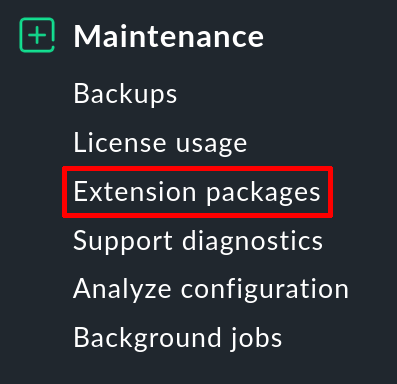
2.1. Adding an MKP
An MKP that you have downloaded from the Exchange, for example, can be uploaded to Checkmk by clicking the Upload package button and will then be made available for installation.
To do this, the file must be present on the machine that is also running your web browser.
The file name of the package must include the .mkp extension.

Following an installation, the extension package will initially be available. It is located under All packages (enabled or disabled):
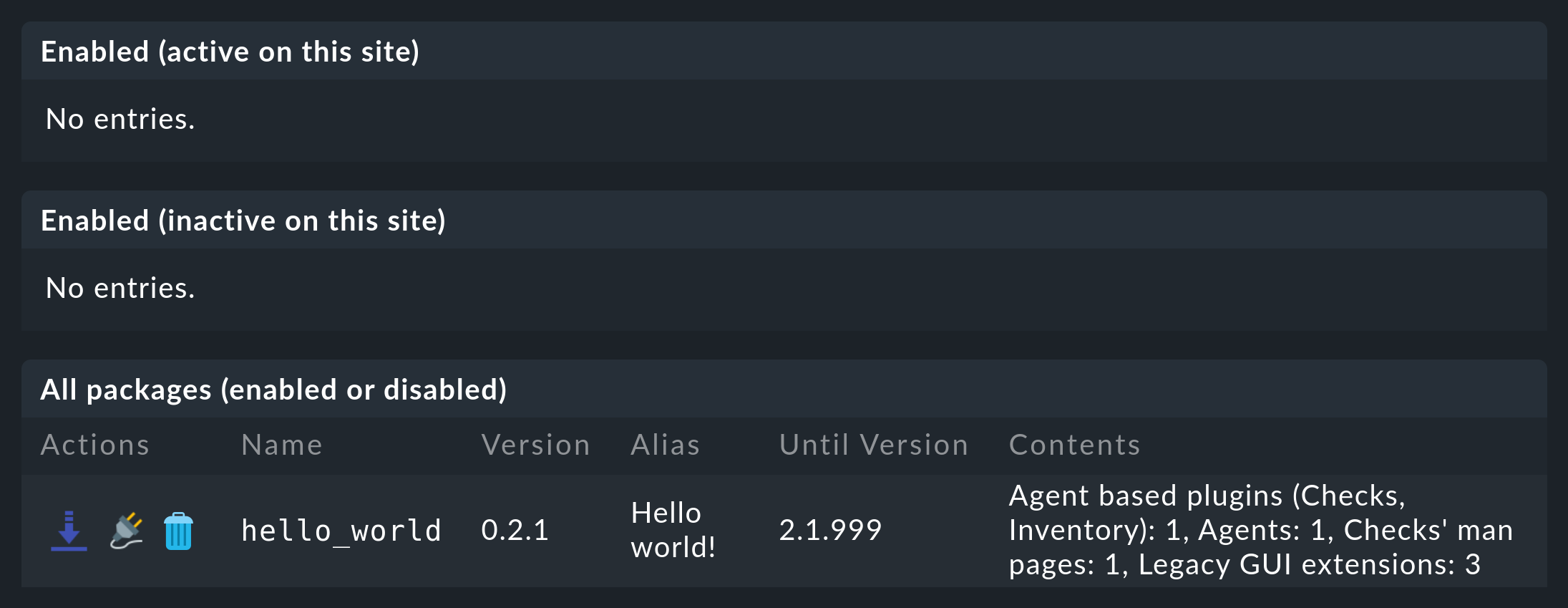
2.2. Activating an MKP
Only with a click on the plug icon ![]() will an available package also be activated.
During activation, the files are installed in a folder hierarchy under
will an available package also be activated.
During activation, the files are installed in a folder hierarchy under ~/local/.
The package description file is also placed in ~/var/check_mk/packages/.
After activation, the package will also appear in the list of enabled and active MKPs — Enabled (active on this site):

Now perform an activation of changes, after which all functions from the package will be anchored in the system and ready for use.
2.3. Disabling and removing packages
The complete deletion of a package is also done in two stages.
With the ![]() button you first deactivate a package in the list of active packages.
In this step the installed files are removed, but the MKP is still kept — this step only reverses the activation.
button you first deactivate a package in the list of active packages.
In this step the installed files are removed, but the MKP is still kept — this step only reverses the activation.
Using the ![]() icon in the list of all packages, you can again delete installed and unused packages.
When deleting, the package is deleted and with it the extension is completely removed — i.e. the opposite of adding a package.
icon in the list of all packages, you can again delete installed and unused packages.
When deleting, the package is deleted and with it the extension is completely removed — i.e. the opposite of adding a package.
2.4. MKPs in distributed environments
In the case of a distributed setup, it is sufficient to make the packages available on the central site.
For each remote site associated with the central site, you can then separately determine whether the customizations should be propagated to that remote site.
All you have to do is activate the Replicate extensions option.
After that, the MKPs and all other changes within the ~/local directory will also be transferred during a synchronization.
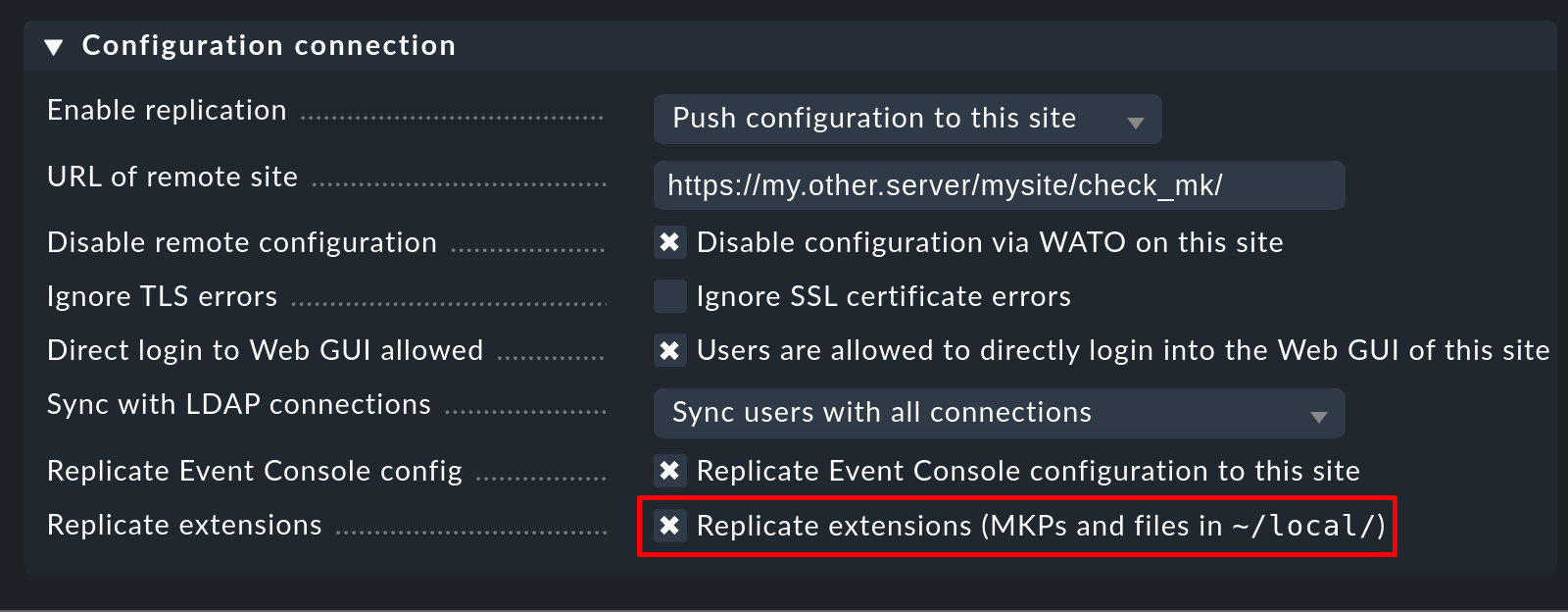
If a particular transfer is not desired, simply turn off the option for this or all sites.
Important: The customizations for the distributed setup will only be transferred if the Enable replication option is set to Push configuration to this site.
2.5. A special case: enabled but inactive packages
A special situation is the attempted activation of a package that does not match the Checkmk version used. Such a package that is enabled, but whose activation fails because of an incompatible Checkmk version, will end up in the Enabled (inactive on this site) list.
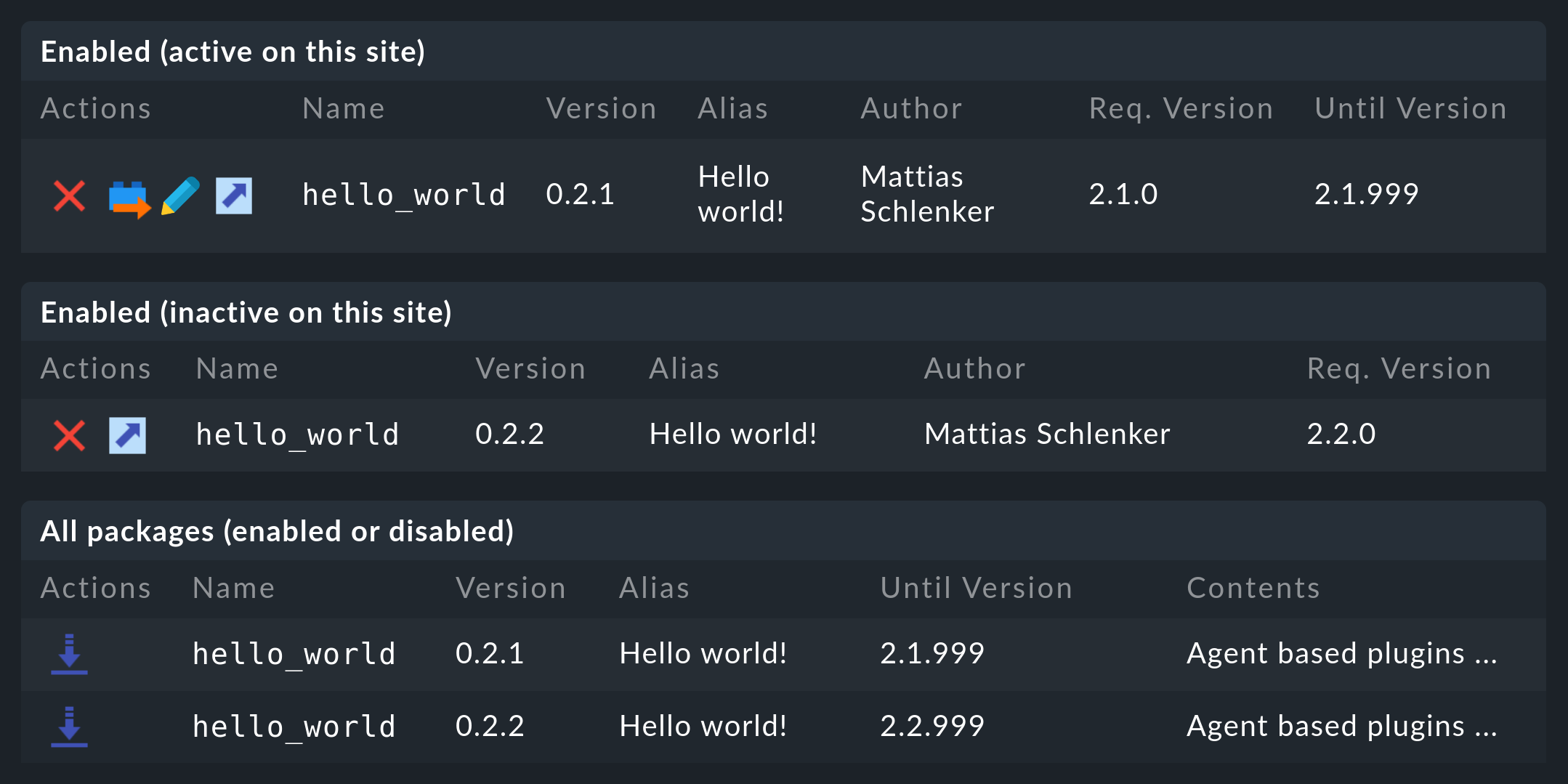
But why install packages that do not match the Checkmk version you are using? There are two good possible reasons:
An update of the Checkmk version: You have the possibility of storing packages for both the old and the new versions — when you next perform an update, the newer package will be activated automatically.
Distributed Monitoring: To facilitate updates, the Checkmk major version of remote sites may be one higher than that of the central site. However, this previously made it difficult to distribute MKPs because these had to be compatible with both major versions. With the ability to unlock mismatched packages, you can keep packages on the central site that match both the source and target versions. The newer version will then be automatically activated during an update.
From the version numbers shown in the above screenshot, you can see that it is a Checkmk 2.1.0 central site that provides packages for remote sites that have already been upgraded to 2.2.0.
3. Managing extension packages via the command line
You can also perform all of the above actions on the command line.
The mkp command is used for this purpose.
If you call it without a subcommand, it shows hints on how to use it.
We have abbreviated the output, which is about 50 lines long, to less than half here for clarity:
OMD[mysite]:~$ mkp
usage: mkp [-h] [--debug] [--verbose] {find,inspect,show,show-all,files,list,add,...}
Command line interface for the Checkmk Extension Packages
options:
-h, --help show this help message and exit
--debug, -d
--verbose, -v Be more verbose
available commands:
{find,inspect,show,show-all,files,list,add,...}
find Show information about local files.
inspect Show manifest of an MKP file.
show Show manifest of a stored package.
show-all Show all manifests.
files Show all files beloning to a package.
list Show a table of all known files, including the deployment state.
add Add an MKP to the collection of managed MKPs.
[...]In the following sections, we will present the most important commands for managing MKPs. A useful command reference can be found as a table at the end of this article.
3.1. Adding an MKP
Adding a package is performed with mkp add.
To do this, of course, you must first bring the MKP file to the Checkmk server (e.g., with scp).
Then run the following command:
OMD[mysite]:~$ mkp add /tmp/hello_world-0.2.2.mkpYou request a list of the available packages with mkp list.
Following an installation, the extension package is initially available, but not active — in the list it will have the Disabled state:
OMD[mysite]:~$ mkp list
Name Version Title Req. Version Until Version Files State
----------- ------- ------------ ------------ ------------- ----- --------
hello_world 0.2.2 Hello world! 2.2.0 2.2.99 6 Disabled3.2. Activating an MKP
Only with the enable subcommand will an available package also be activated.
Specifying the version number is only required in the event that the name alone is not unique:
OMD[mysite]:~$ mkp enable hello_world 0.2.2When activated, the files are installed in a directory hierarchy within ~/local/ and the package description file is placed in ~/var/check_mk/packages/.
This results in the package getting the Enabled (active on this site) state:
OMD[mysite]:~$ mkp list
Name Version Title Req. Version Until Version Files State
----------- ------- ------------ ------------ ------------- ----- -----------------------------
hello_world 0.2.2 Hello world! 2.2.0 2.2.99 6 Enabled (active on this site)Details on an individual package can be obtained with mkp show, its actual activation status does not matter:
OMD[mysite]:~$ mkp show hello_world 0.2.2
Name: hello_world
Version: 0.2.2
Packaged on Checkmk Version: 2023.01.16
Required Checkmk Version: 2.2.0
Valid until Checkmk version: 2.2.99
Title: Hello world!
Author: Mattias Schlenker
Download-URL: https://exchange.checkmk.com/p/hello-world
Files:
Agent based plugins (Checks, Inventory)
hello_world.py
Agents
plugins/hello_world
Checks' man pages
hello_world
Legacy GUI extensions
plugins/metrics/helloworld_metric.py
plugins/perfometer/helloworld_perfometer.py
plugins/wato/helloworld_parameters.py
Description:
This is a very basic plugin with the sole purpose to be used as template for your own plugin development.3.3. Deactivating and removing packages
Uninstalling a package is done in two stages.
First, the package is disabled with mkp disable.
This deletes installed files, but still keeps the package — for a possible later reactivation, for example.
Again, specifying the version number is only necessary in the event that the package’s name alone is not unique:
OMD[mysite]:~$ mkp disable hello_world 0.2.2In the package list you will now see the Disabled state when you call mkp list again:
OMD[mysite]:~$ mkp list
Name Version Title Req. Version Until Version Files State
----------- ------- ------------ ------------ ------------- ----- --------
hello_world 0.2.2 Hello world! 2.2.0 2.2.99 6 DisabledOnly mkp remove will delete the package irrevocably:
OMD[mysite]:~$ mkp remove hello_world 0.2.23.4. A special case: enabled but inactive packages
A special situation is when a package is installed that does not match the Checkmk version being used:
OMD[mysite]:~$ mkp install /tmp/hello_world-0.2.3.mkp
The package requires Check_MK version 2.3.0, but you have 2.2.0b1 installed.You can activate such a package, but the activation will fail because of the incompatible Checkmk version, and the package will get the Enabled (inactive on this site) state.
OMD[mysite]:~$ mkp list
Name Version Title Req. Version Until Version Files State
----------- ------- ------------ ------------ ------------- ----- -------------------------------
hello_world 0.2.3 Hello world! 2.3.0 2.3.99 6 Enabled (inactive on this site)
hello_world 0.2.2 Hello world! 2.2.0 2.2.99 6 Enabled (active on this site)We explained the possible circumstances for choosing to install incompatible packages — i.e. with updates in distributed environments — earlier above in the corresponding Setup section.
Similarly to the Setup procedure, use mkp enable packagename version to enable a package, or mkp disable packagename version to disable an existing enable.
4. MKPs for developers
Most of us who know or learn programming are "like dwarfs standing on the shoulders of giants to be able to see more and more distant than them": It is in Open Source that we can really benefit from the earlier work of others. In the case of Checkmk, this is especially true for extensions, which, in the context of the GPL are works derivative of Checkmk itself, which in turn is subject to the GPL (version 2.0). Specifically, this means that you can customize packages downloaded from the Checkmk Exchange to your heart’s content (or simply for current needs).
In the following sections we show — starting from repackaging with minor changes, to resolving an existing (example) package, to compiling unpackaged files — all of the relevant steps presented in the typical sequence in which they are performed.
If you are programming or modifying your own plug-ins for Checkmk, see the articles on the existing programming interfaces, the integration into the Agent Bakery and the guidelines for check plug-ins.
4.1. Editing packages
The correction of minor errors often makes it necessary to adapt an existing package without changing its structure or name. In this case, it is advisable not only to adapt the existing files stored in the file system, but also to at least update the package’s version number. If changes to Checkmk’s APIs require modifications to a package, also adjust the version numbers stored in the package for the minimum and maximum supported versions. In addition, when using the Agent Bakery, the presence of new MKPs triggers the rebuilding of the agent packages.
In the commercial editions use the ![]() icon to get to the modifications dialog.
icon to get to the modifications dialog.
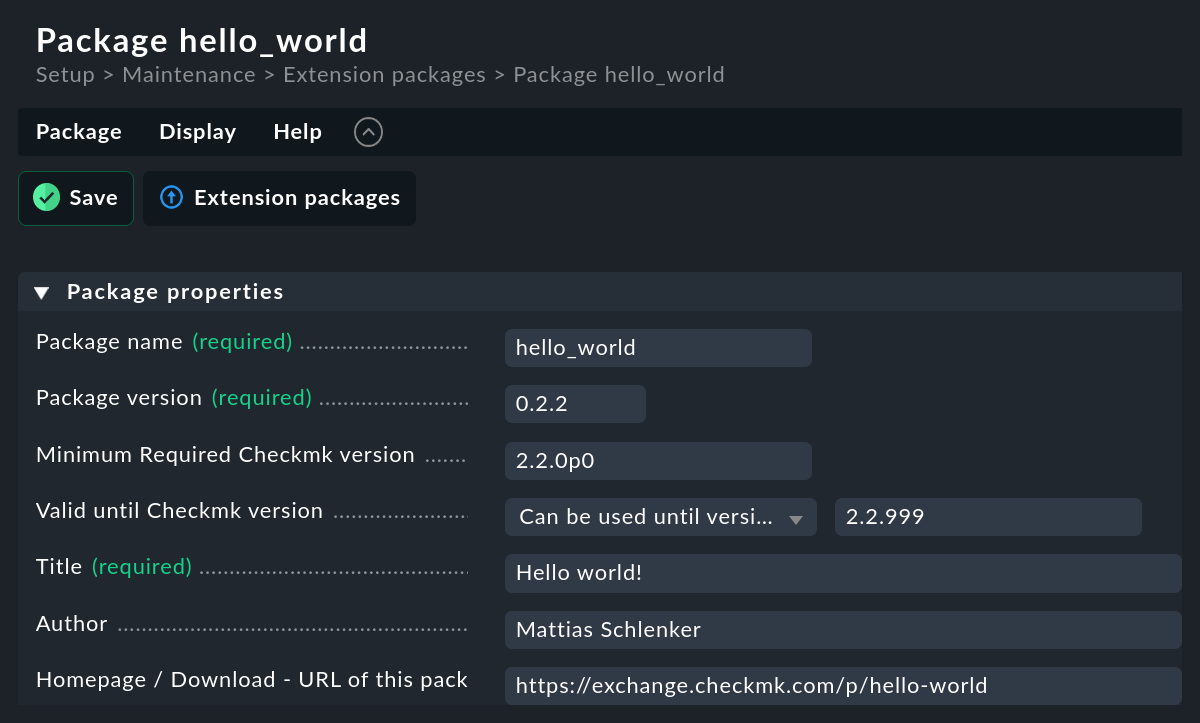
4.2. Unpacking packages
The Setup menu
The ![]() unpacking of a package 'frees' the packaged files within
unpacking of a package 'frees' the packaged files within ~/local/, so to speak, and removes only the package description.
As a result, the files will be unpackaged and the extensions will remain active.
This is the opposite of creating a package from previously unpackaged files.
In practice, you will most likely need to unpackage when you want to customize an extension and later repackage it to include any modifications. For example, you can get started with our Hello world! example, which does nothing actually useful but can serve as a template for your first custom package.
The command line
On the command line, you can release a package with the mkp release command.
The package to be unpacked must have the Enabled (active on this site) state for this to work.
The actual extension files are retained and only the package description is deleted:
OMD[mysite]:~$ mkp release hello_worldThe original package remains intact and changes its state to Enabled (inactive on this site). It can thus also serve as a backup in case something goes wrong during customization. Then simply delete the 'redundant' files, re-enable the package and start over.
4.3. Finding unpackaged files
The Setup menu
Once the programming or customization work has been completed, it will be necessary to find the existing and added files again. Since these files do not currently belong to any package, they are listed in the Setup under Unpackaged files:
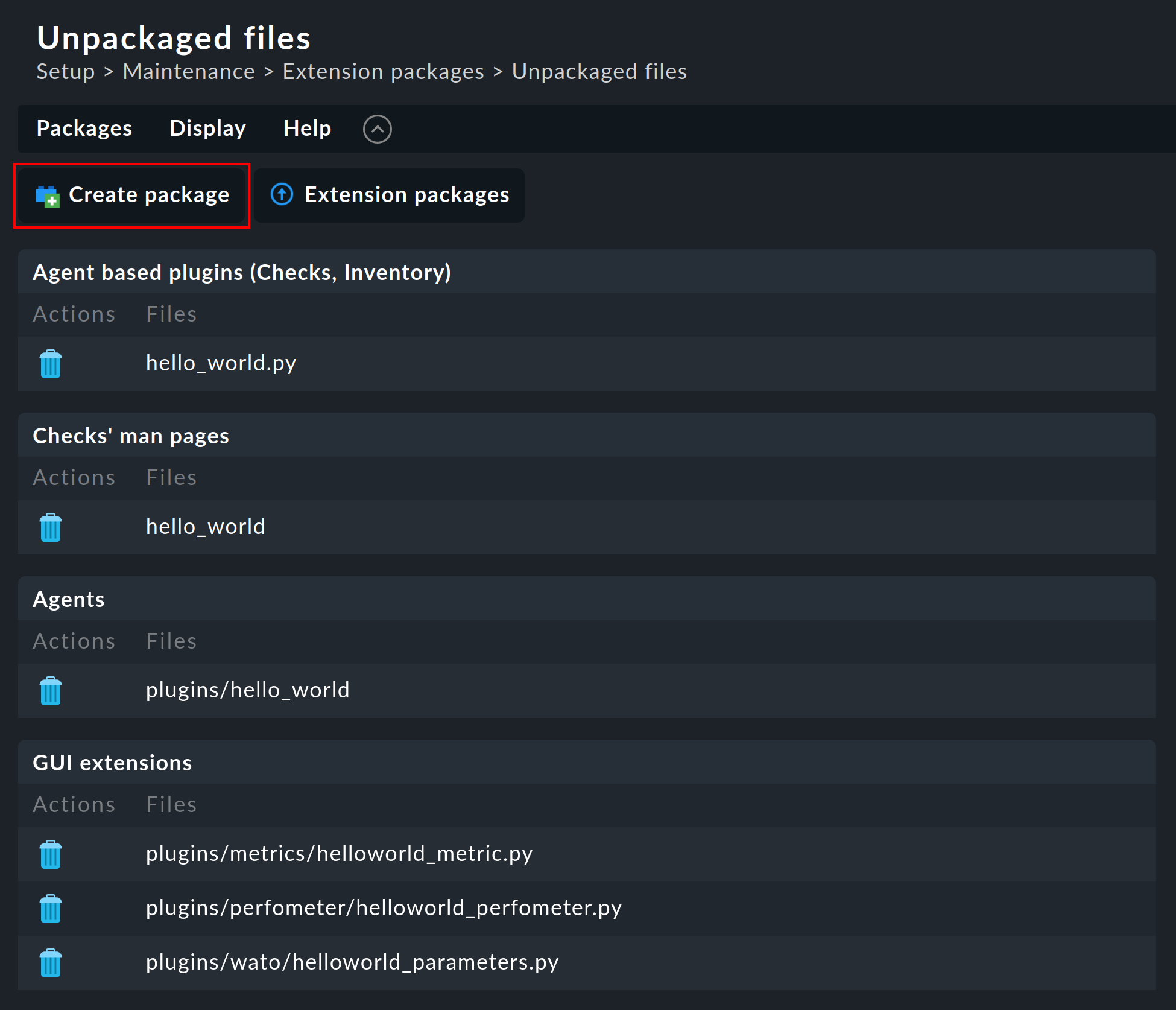
The command line
The command line equivalent is mkp find:
OMD[mysite]:~$ mkp find
File Package Version Part Mode
------------------------------------------- ------- ------- --------------------------------------- ----------
hello_world.py Agent based plugins (Checks, Inventory) -rw-r--r--
plugins/hello_world Agents -rwxr-xr-x
hello_world Checks' man pages -rw-r--r--
plugins/perfometer/helloworld_perfometer.py Legacy GUI extensions -rw-r--r--
plugins/metrics/helloworld_metric.py Legacy GUI extensions -rw-r--r--
plugins/wato/helloworld_parameters.py Legacy GUI extensions -rw-r--r--Delete files that are not needed, or note which files should not be included in the new package. In the next step, the unpackaged files will then be (again) combined into a package.
4.4. Creating packages
The Setup menu
The ![]() Create package button in the unpackaged files overview takes you to the dialog for creating a new package:
Create package button in the unpackaged files overview takes you to the dialog for creating a new package:
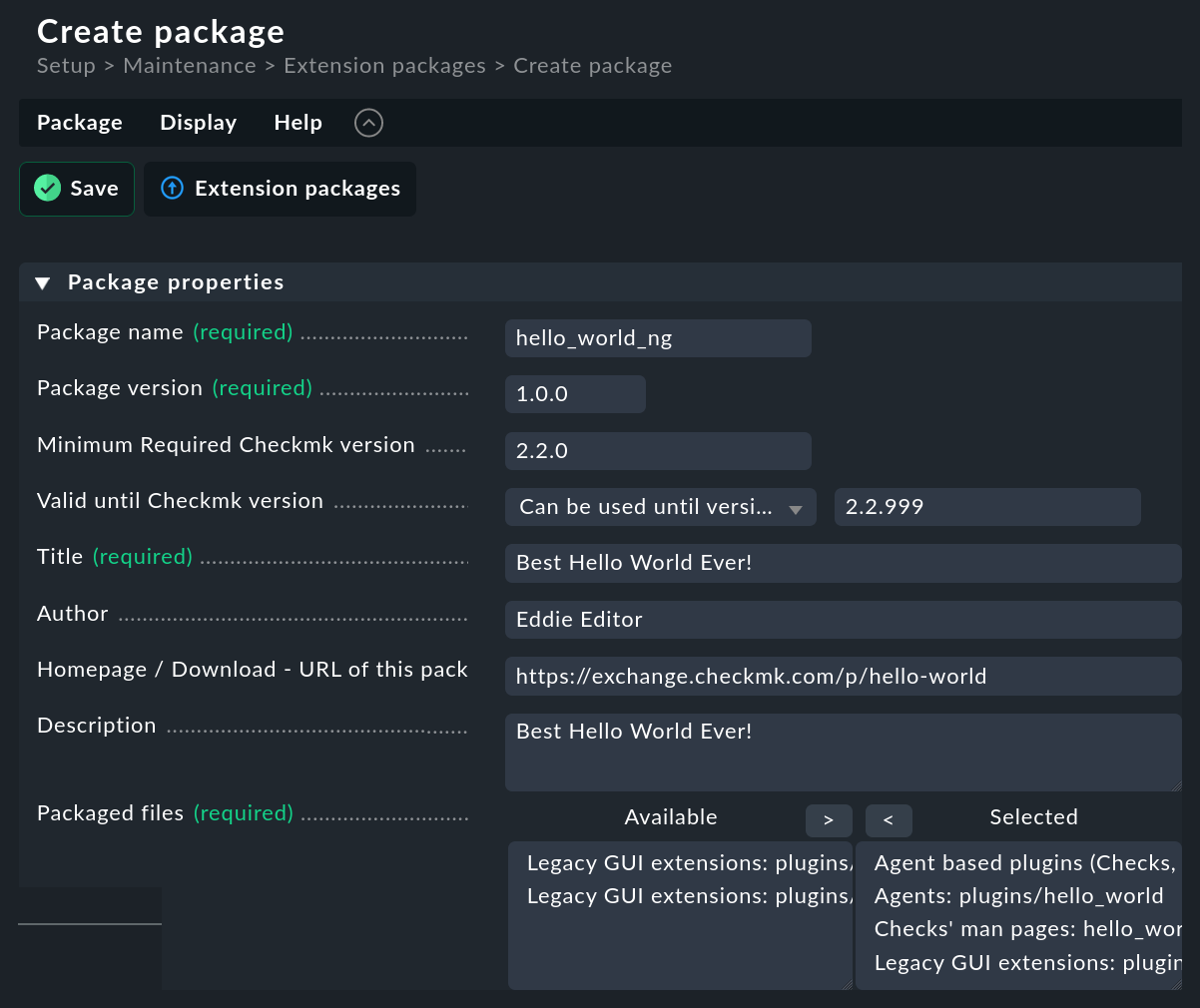
In addition to the obvious details, it is important that you select at least one file to be packaged.
Creating a package also creates a package description under ~/var/check_mk/packages/,
which contains general information as well as the list of the included files.
Extensions that use the APIs introduced with Checkmk 1.6.0 and already marked as deprecated in Checkmk 2.0.0 will no longer be supported by Checkmk 2.3.0. Enter 2.2.99 here as the maximum supported version. Extensions that use the APIs introduced in Checkmk 2.0.0 will work up to Checkmk 2.3.0 without adjustments, but not with Checkmk 2.4.0. You can enter 2.3.99 as the maximum supported Checkmk version here. |
You can now download this new package as an MKP file via the package list with the ![]() icon — to transfer it to another system or to upload it to the Exchange, for example.
icon — to transfer it to another system or to upload it to the Exchange, for example.
The command line
The procedure for creating MKPs on the command line is analogous to that in the Setup menu.
First, use mkp template to create a package configuration which (for now) contains all of these files.
Specify the desired name for the new package as a parameter:
OMD[mysite]:~$ mkp template hello_world_ng
Created 'tmp/check_mk/hello_world_ng.manifest.temp'.
You may now edit it.
Create the package using mkp package tmp/check_mk/hello_world_ng.manifest.temp.You now edit the properties of the package with a text editor:
{'author': 'Add your name here',
'description': 'Please add a description here',
'download_url': 'https://example.com/hello_world_ng/',
'files': {'agent_based': ['hello_world.py'],
'agents': ['plugins/hello_world'],
'checkman': ['hello_world'],
'web': ['plugins/metrics/helloworld_metric.py',
'plugins/perfometer/helloworld_perfometer.py',
'plugins/wato/helloworld_parameters.py']},
'name': 'hello_world_ng',
'title': 'Title of hello_world_ng',
'version': '1.0.0',
'version.min_required': '2.2.0',
'version.packaged': '2.2.0b1',
'version.usable_until': None}Edit this file according to your requirements.
Pay attention to correct Python syntax — Unicode strings (texts containing non-ASCII characters such as umlauts) must be prefixed with a small u for example.
Under the files entry, you can remove files that should not be packaged.
At version.min_required enter the minimum version of Checkmk that is required to be able to use the package.
When done, you can create an MKP file with mkp package:
OMD[mysite]:~$ mkp package tmp/check_mk/hello_world_ng.manifest.temp
[hello_world_ng 1.0.0]: InstallingPackages are stored under ~/var/check_mk/packages_local:
OMD[mysite]:~$ ll ~/var/check_mk/packages_local/*.mkp
-rw-rw---- 2 mysite mysite 4197 Feb 20 13:19 hello_world_ng-1.0.0.mkp5. The MKP package format
You may want to program and package new extension packages on a development machine, and then transfer the finished package to the Checkmk server for testing.
This is quite easy to do since the MKP format is simply a .tar.gz file, which in turn contains .tar files and manifest files.
Examining the downloaded hello_world-0.1.3.mkp reveals the first level of its structure:
user@host:~$ tar tvf hello_world-0.1.3.mkp
-rw-r--r-- 0/0 1153 2021-10-08 09:35 info
-rw-r--r-- 0/0 973 2021-10-08 09:35 info.json
-rw-r--r-- 0/0 10240 2021-10-08 09:35 agent_based.tar
-rw-r--r-- 0/0 10240 2021-10-08 09:35 checkman.tar
-rw-r--r-- 0/0 10240 2021-10-08 09:35 agents.tar
-rw-r--r-- 0/0 10240 2021-10-08 09:35 web.tarUnpack the package into a temporary directory, and there you can view the contents of the included tar archives. The file paths are relative to the directory that contains their respective components:
user@host:~$ tar tvf web.tar
-rw-r--r-- 0/0 698 2021-10-08 09:04 plugins/metrics/helloworld_metric.py
-rw-r--r-- 0/0 676 2021-10-08 09:04 plugins/perfometer/helloworld_perfometer.py
-rw-r--r-- 0/0 2383 2021-10-08 09:27 plugins/wato/helloworld_parameters.pyAnd what about the two manifest files info and info.json?
You have already seen the info file and its fields contained in the Python Dict format above.
The JSON equivalent info.json contains exactly the same fields and values, but has been serialized in the JSON format.
If you want to build the package as part of a script, you should input the Python dict file info and generate the JSON info.json file from this before packaging.
When you repack the archives, be careful not to include file paths that are not part of the folder hierarchy under ~/local.
The top level must contain only the manifests and tar files.
Also, pack here with UID and GID 0.
6. Command reference
6.1. Management
| Subcommand | Parameter | Function |
|---|---|---|
|
File name of the package to be added |
Makes a package available, but does not activate it yet. |
|
Name of the package (and version number, if applicable) |
Activates a package for local use or for distribution to remote sites, depending on version compatibility. |
|
Name of the package and version number |
Disables a package, which remains available in the file system. |
|
Package name and version number |
Removes a previously disabled package completely. |
|
File name of the package to add |
This subcommand is deprecated and will be removed soon! |
|
none |
Lists all available packages and their activation state. |
|
File name of the package to inspect |
Shows information about an uninstalled MKP. |
|
Name of the package (and version number if applicable) |
Displays information about an available MKP. |
|
none |
Displays information about all available MKPs. |
|
Package name (and version number if applicable) |
Lists all files belonging to a package. |
6.2. Development
| Subcommand | Parameter | Function |
|---|---|---|
|
Name of package |
Resolves an active package. |
|
none |
Lists all files not belonging to any package. |
|
Name of new package to create |
Creates a manifest file as the base for a new package. |
|
Path to manifest file |
Creates an MKP based on the contents of a manifest file. |
6.3. Updates
| Subcommand | Parameter | Function |
|---|---|---|
|
none |
Disables packages that no longer match the Checkmk version after an update. |
|
none |
Activate packages matching the Checkmk version after an update. |
